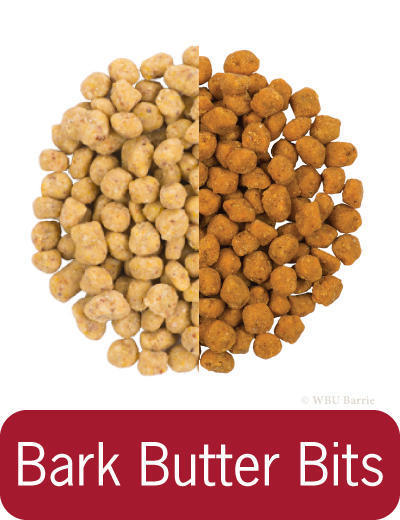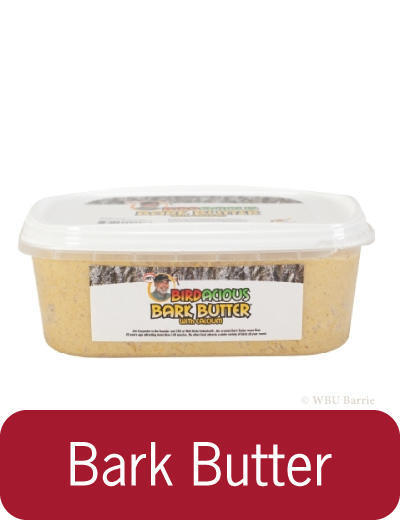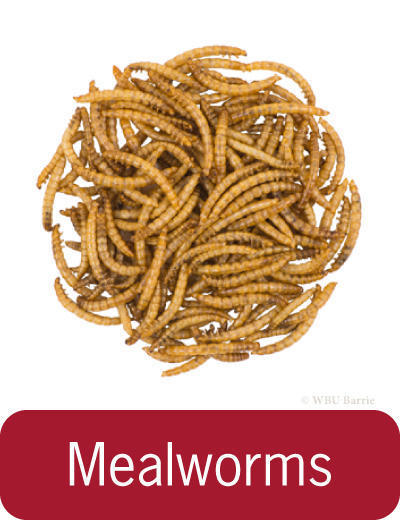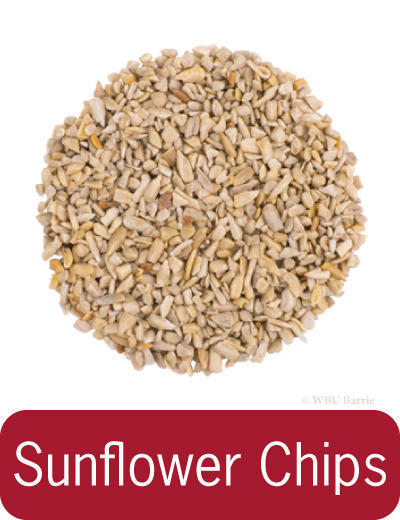Attracting Eastern Bluebirds to Your Backyard
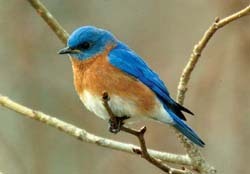 As Henry David Thoreau once said “The Bluebird carries the sky on its back”. It would be hard to find anything as dazzling as a Bluebird standing on a fence post in the early morning sun. Its brilliant blue plumage might even be said to rival the sky itself. Bluebirds are found throughout North America and Simcoe County is home to the Eastern Bluebirds. Bluebirds are most commonly observed out in the country as they perch on fences and telephone wires. We are always getting asked how to attract Eastern Bluebirds and our answer is always the same "tell me about the habitat around your house". If you are in the right habitat attracting bluebirds is not all that difficult. Eastern Bluebirds live in open areas including open fields, meadows, fence rows, abandoned orchards, large lawn, golf courses, parks, roadsides, farms and pastures. While most Eastern Bluebirds migrate into the south-central United States and Mexico a few will remain in Ontario during the winter if they have access to food, water and shelter.
As Henry David Thoreau once said “The Bluebird carries the sky on its back”. It would be hard to find anything as dazzling as a Bluebird standing on a fence post in the early morning sun. Its brilliant blue plumage might even be said to rival the sky itself. Bluebirds are found throughout North America and Simcoe County is home to the Eastern Bluebirds. Bluebirds are most commonly observed out in the country as they perch on fences and telephone wires. We are always getting asked how to attract Eastern Bluebirds and our answer is always the same "tell me about the habitat around your house". If you are in the right habitat attracting bluebirds is not all that difficult. Eastern Bluebirds live in open areas including open fields, meadows, fence rows, abandoned orchards, large lawn, golf courses, parks, roadsides, farms and pastures. While most Eastern Bluebirds migrate into the south-central United States and Mexico a few will remain in Ontario during the winter if they have access to food, water and shelter.
They will come to bird feeders for certain foods, bird baths for water and bird houses for nesting. Here are some of the foods, feeders, bird baths and houses you can offer Eastern Bluebirds to encourage them to visit and stay in your yard.
For more information on Eastern Bluebirds visit these two great resources:
Lab of Ornithology at Cornell- All About Birds: www.allaboutbirds.org/guide/Eastern_Bluebird
Foods
Bluebirds are often seen sitting on fence posts and fences or tall vegetation in a field waiting for insects. Eastern Bluebirds primarily eat insects and spiders as well as fruit, but they will also gladly accept a few foods from bird feeders. Bluebirds love live mealworms and can be drawn in close by offering a small dish with mealworms. Live mealworms are the best way to attract bluebirds. Here are some of the foods bluebirds enjoy at bird feeders:
Feeders
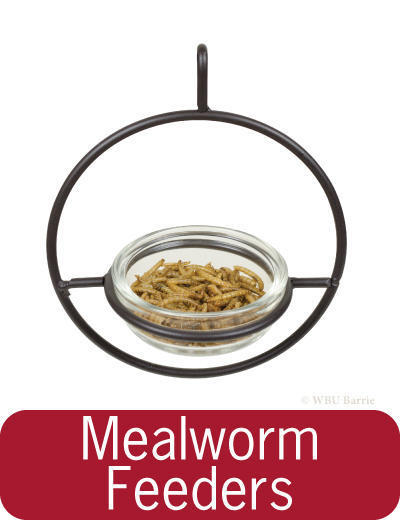
Birdbaths (Water)
Water is essential to all birds and providing a bird bath means they don’t have to travel great distances to find water. Water in a bird bath should be cleaned regularly as birds defecate, leave bits of food and feathers in the bath, not to mention leaves and other items that can end up in a bath. In the winter, heated birdbaths provide an excellent place for birds to drink. In fact, most encounters with Eastern Bluebirds during the winter months take place by small streams and flowing water that is open all winter long.
Bluebird Houses (Nest Boxes)
Eastern Bluebirds are cavity nesters and will use artificial nest boxes. Habitat and nest cavities had been disappearing for many years but bluebirds have made an incredible comeback due to thousands of bluebird nest boxes being installed across the country. Eastern Bluebirds reliably use nesting boxes to raise their families. Bluebirds like to nest in areas including open fields, meadows, fence rows, abandoned orchards, large lawn, golf courses, parks, roadsides, farms and pastures. If you live in an area with ideal habitat for bluebirds try putting out a Bluebird Nest Box to encourage these beautiful birds to stay in your yard. Bluebird house can be mounted on the WBU Advanced Pole System® (APS) Basic Setup Mounting Hardware or a fence. Poles systems tend to offer the best protection from predators. Bluebird boxes should be mounted 5 to 6 feet above the ground and facing away from prevailing winds, and 50 to 100 meters apart. Try to place the boxes close to trees shrubs or fences. Bluebirds will use them when feeding and when young ones are learning to fly.
Not all bird houses on the market are made for Eastern Bluebirds. Make sure any nest box you place out for them meets the following specifications. Nest boxes should have an opening of 1½”, the entrance should be located 6-7” above the floor of the box, the size of the floor should be 4” x 4”. Bird houses with predator guards will help deter squirrels from chewing and making the entrance hole larger.
Eastern Bluebird breed from late April through July and nest boxes should be placed out for use in March so birds may inspect the box when they return from their migration. Eastern Bluebirds use grasses, pine needles, grass and other vegetation to make their nest. While it is very exciting to have birds nest in your nest box resist the temptation disturb them too much. They lay 4-5 clear blue eggs and the eggs hatch after an incubation period of 12-15 days. The young birds fledge when they are 15-18 days old. Eastern Bluebirds will have 2-3 broods in a season, so it is important that you do not clean out your nesting box until the early fall (late September).
After the nesting season (late September to be safe), inspect your nest boxes and perform needed maintenance. After the nesting season has ended clean out old nests and rub the interior surfaces with unscented ivory soap as a wasp deterrent. Make sure nest boxes are in good condition and mounted securely. Consider moving the nest box to a different location if it has been unproductive.
If House Sparrows take over the bird box try mounting a second box 5-15 feet away from the first. Sparrows will only nest in one leaving the other for bluebirds. If Tree Swallows competes for the nest site, place another box near the first (15 to 25 feet from the original house). Tree Swallows will help keep other swallows away from both boxes. They seem to tolerate overlapping territories of other species, but not their own.
Roosting Boxes (Shelter)
Eastern Bluebirds and other cavity dwelling birds seek shelter during cold nights of the winter months. Shelter is essential for their survival in harsh conditions. Roosting boxes provide shelter for birds on very cold nights. Roosting boxes differ from a typical bird house because they feature a hole on the bottom of the box to trap heat and three dowels on the inside of the house to accommodate multiple perching birds. At WBU McKinney we offer Convertible Winter Roosting boxes which can be flipped to convert it to an Eastern Bluebird house after the winter season.
Fun Facts
- Bluebirds may raise two and sometimes three broods per season. Pairs may build their second nests on top of the first nest or they may nest in an entirely new site. The male continues to take care of the recently fledged young while the female begins to re-nest. Young of the first brood will occasionally help raise their siblings in the second brood.
- Bluebirds have no blue pigments in their feathers. Instead, each feather barb has a thin layer of cells that absorb all wavelengths of color except blue. Only the blue wavelength is reflected and scattered, resulting in their blue appearance to our eyes.
- Bluebirds can fly at speeds up to 72 kmh (45 mph) if necessary.


